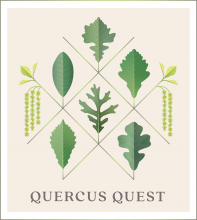Project Overview:

The world’s estimated 425 oak species exchange genes with their close relatives through hybridization. The Quercus Quest campaign is supported by a grant from the National Science Foundation's Dimensions of Biodiversity Program (learn more about our research partners below), which is investigating how this exchange of genetic material allows oaks to adapt to new environments, and how oaks then shape the populations of insect and fungal species that depend on them. Because hybridization depends on the timing of pollen movement between species, and because the fungi and insects that live on oaks respond to the timing of leaf and root production, phenology is key to understanding the complexities of oak ecosystems.
Your data collected as part of this campaign will be used to understand the relationship between climate and leaf and flowering phenology in eastern white oak, bur oak, and their relatives.
Learn more about this research from the researchers behind this campaign in this recorded webinar.
SIGN UP FOR Quercus Quest MESSAGES!
You will receive messages full of findings, observation tips, and campaign-specific opportunities. Don't miss out!
HOW TO PARTICIPATE:
1. Join Nature's Notebook. If you haven't already, create a Nature's Notebook account. If you need more details on getting started, take the Observer Certification Course available at learning.usanpn.org. You can also view this webinar recording that describes how to participate in the campaign.
2. Select one (or more) individual oak trees to track from the list below. Need help identifying oaks? Check out this great resource from the US Forest Service.
- white oak (Quercus alba)
- swamp white oak (Quercus bicolor)
- sand live oak (Quercus geminata)
- overcup oak (Quercus lyrata)
- bur oak (Quercus macrocarpa)
- swamp chestnut oak (Quercus michauxii)
- chestnut oak (Quercus montana)
- chinquapin oak (Quercus muehlenbergii)
- dwarf chinquapin oak (Quercus prinoides)
- post oak (Quercus stellata)
- southern live oak (Quercus virginiana)
Note: When you register your oak tree(s), please include details on the Add or Edit a Plant page in your Observation Deck about whether the tree was planted (if known), and if so, the approximate planting date.
3. Take observations. We invite you to track leafing and flowering in your trees ideally 2-4 times a week, in the spring and autumn. We are especially interested in the following phenophases, though you are welcome to report on fruiting as well.
4. Report your observations. As you collect data during the season, log in to your Nature's Notebook account and enter the observation data you recorded. You can also use the Nature's Notebook app to submit your observations!
Research team
 |
Andrew Hipp, Senior Scientist in Plant Systematics and Herbarium Director, The Morton Arboretum |
 |
Heather McCarthy, Department of Microbiology and Plant Biology, University of Oklahoma |
 |
Jeannine Cavender-Bares, University of Minnesota |
 |
Ian Pearse, U.S. Geological Survey, Fort Collins Science Center, Fort Collins, CO |
 |
Paul Manos, Professor, Department of Biology, Duke University |
This campaign is supported by the NSF Awards 2129237, 2129236, 2129312, 2129281.
 We are collaborating on this campaign with Adventure Scientists, which engages volunteers in collecting data in far flung places! The phenology data that their volunteers collect will help to fill in the geographic gaps across the range of white oaks.
We are collaborating on this campaign with Adventure Scientists, which engages volunteers in collecting data in far flung places! The phenology data that their volunteers collect will help to fill in the geographic gaps across the range of white oaks.
Questions about this campaign? Email Erin Posthumus, USA-NPN Outreach Coordinator at erin@usanpn.org.



